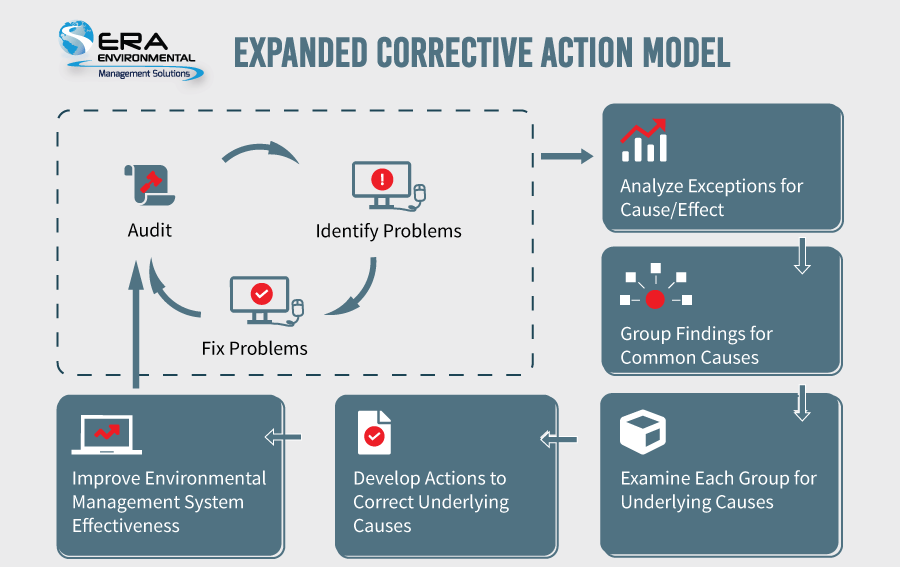Waiting for external EHS auditing is one of the main reasons most companies are fined heavily by federal agencies. Checking if you meet your EHS requirements beforehand is the best way to ensure that you pass every external audit while staying in Environmental and Health and Safety Compliance.
Completing routine Internal EHS Audits helps by:
- Discovering EHS errors and Progressing Towards Hazard Elimination.
- Improving Operations Efficiency and Reducing Company Costs
- Producing actionable data. Solid record-keeping – proof of audit, EHS audit findings, inspection notes, corrective actions.
- Improves company image and production efficiency.

Discovering EHS Errors and Progressing Towards Hazard Elimination.
Discovering errors is essential to your business and facility because it helps you to correct them before an external auditor catches them.
Internal EHS audits involve careful evaluation of company practices and an extensive EHS audit procedure. These involve the inspection of equipment such as:
- Paint booths
- Forklifts
- Emission Control Equipment
- Storage Tanks
- valves
- vessels
- pumps
Locations such as:
- paint shops
- cast house
- waste container staging areas
- wastewater treatment
- assembly
- machine shops
- warehouses
- labs
- office buildings
Environmental reporting helps you to monitor everything from releases to the proper SDS for each chemical. The employees in the facility may not have knowledge of the hazards of the chemical that they are using. Without frequent EHS auditing that ensures the presence of updates SDSs in the facility, there is more room for hazards to occur.
Workplace practices also need to be assessed for safety. If they produce significant hazards, they may either be changed to eliminate the hazard or be scrapped to ensure workplace safety.
An Example of Hazard Elimination Steps
An example of this is how companies have had to improve the provision of personal protective equipment (PPE) for their employees. Without effective internal audits, the gaps in PPE would not have been identified and it would not have been improved. Other manufacturing plants have PPE instructions, charts and training gear that give instructions such as the type of masks to be worn in different warehouses. These are based on their internal audit findings.
Improving practices in this way will also help you to pass your external audits. This helps you to avoid using band-aid solutions to your problems and forces you to make real changes from the source.
Improving Operations Efficiency and Reducing Company Costs
So, now you might be thinking, what if your company has no findings? What if you complete every task perfectly? In addition to helping you to avoid errors, it can also help you to improve processes, self-auditing also helps you to identify points of improvement. Not only is a leaking valve an H&S hazard, but it also causes a loss of resources that would otherwise be useful to the organization. Various companies switch their equipment to using more efficient equipment that saves money.
An Example of Improvement from Audits
This has been employed in the automotive industry to constantly audit their processes including their pollution prevention requirements. This helps them to identify opportunities for growth. They are constantly improving maintenance, scheduling and record keeping. They also replace paint feeders that don’t use up all the paint with advanced systems that waste less paint. This, coupled with good record-keeping, sets an example for other companies. The best way to improve record-keeping is to use EHS auditing software to assist with answering all relevant audit questions.
Improvements can also be introduced to other companies, sister facilities and subsidiaries and establish you as a thought leader in operations improvements.
Producing Actionable Data.
Internal EHS audits improve recordkeeping and provide concrete data of what should be improved as well as strategies for corrective action. The type of records that can be used:
- proof of audit
- internal EHS audit findings
- inspection notes
- corrective actions
Having proof of audit will make any external audits that your facility faces run smoothly. Inspection notes also provide information to the executives about processes and equipment that needs to be upgraded. Corrective actions can help to fix the potential problems before you are fined by federal organizations.
Benefits of Improving Company Image to Both the EPA and the Public
Protecting and aiding your company image is made easier if you have strong proof of records. Proving that your company cares about environmental compliance and employee safety builds trust with the public and with investors. Some companies release full sustainability reports to the public to demonstrate employee safety, equity, and emission monitoring. This encourages people who engage with the company to do so with confidence.
Do You Need Help with Internal EHS Audits?
As you can see internal audits are not only important for staying out of trouble but also for improving your company operations and image. Therefore, you should consider doing them periodically.
ERA’s auditing and inspection software allows you to define your own inspection checklists according to your facility requirements but also helps you with OSHA audit by providing all the required forms. OSHA has many resources that can help you in risk identification processes. They have assessment processes and checklists that can ensure that you are identifying hazards effectively. If you would like to take advantage of this software, click below to book a free consultation call with a Project Analyst.
This Blog Was Co-Authored By:


Tags:
EH&S InspectionsApril 11, 2012

Comments